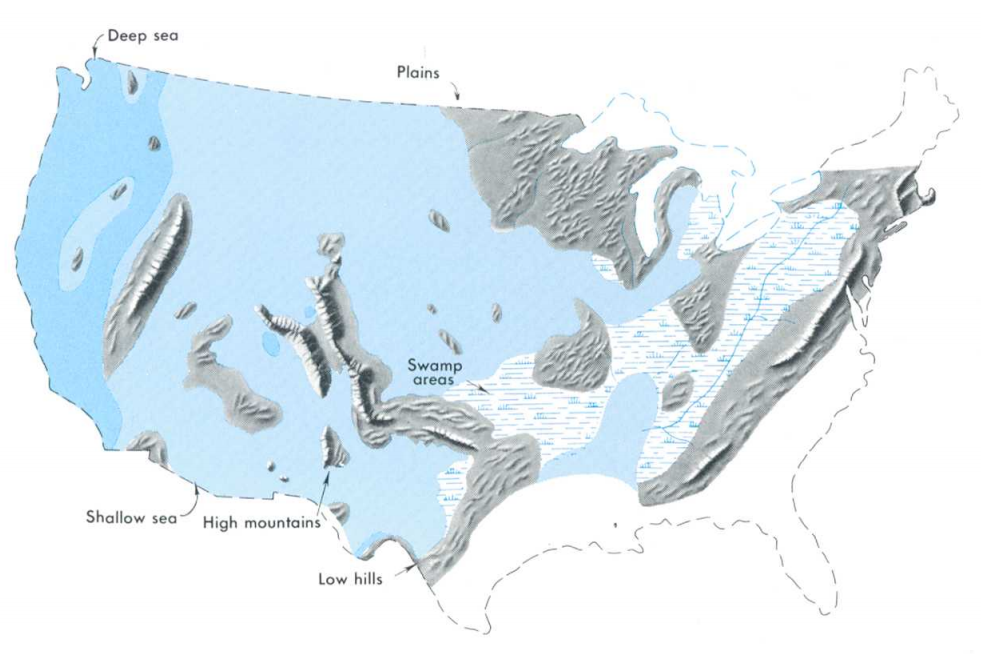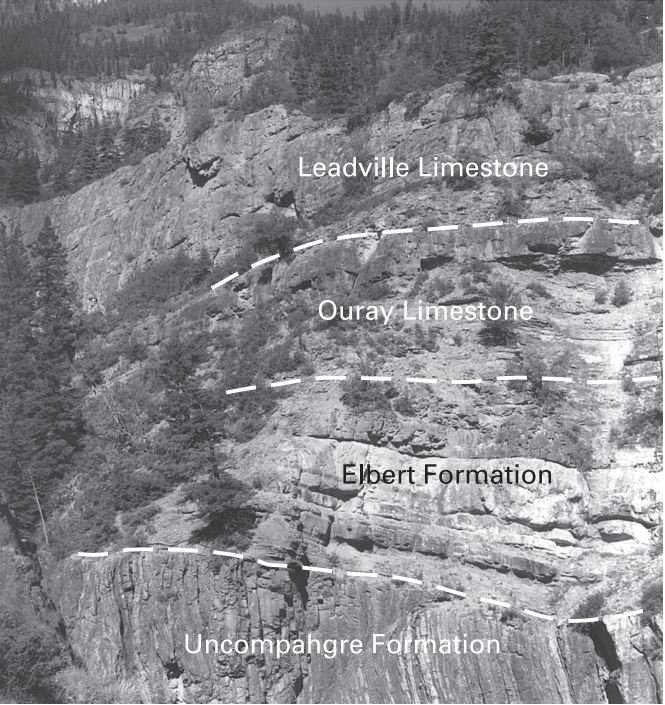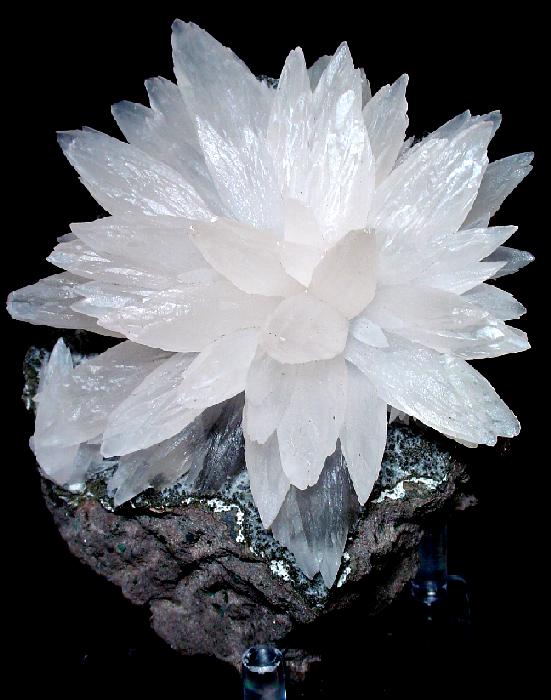|
Paradox Basin
The Paradox Basin is an asymmetric foreland basin located mostly in southeast Utah and southwest Colorado, but extending into northeast Arizona and northwest New Mexico. The basin is a large elongate northwest to southeast oriented depression formed during the late Paleozoic Era. The basin is bordered on the east by the tectonically uplifted Uncompahgre Plateau, on the northwest by the San Rafael Swell and extends partway into the Monument Uplift to the west. Its area is roughly 33,000 square miles (85470 km2). The combined sedimentary strata of the Paradox Basin are more than 15,000 feet (4600 m) thick in some places. Unlike most Rocky Mountain basins, the Paradox Basin is an evaporite basin containing sediments from alternating cycles of deep marine and very shallow water. As a result of the thick salt sequences and the fact that salt is ductile at relatively low temperatures and pressures, salt tectonics play a major role in the post- Pennsylvanian structural defor ... [...More Info...] [...Related Items...] OR: [Wikipedia] [Google] [Baidu] |
Pennsylvanian (geology)
The Pennsylvanian ( , also known as Upper Carboniferous or Late Carboniferous) is, on the International Commission on Stratigraphy, ICS geologic timescale, the younger of two period (geology), subperiods of the Carboniferous Period (or the upper of two system (stratigraphy), subsystems of the Carboniferous System). It lasted from roughly . As with most other geochronology, geochronologic units, the stratum, rock beds that define the Pennsylvanian are well identified, but the exact date of the start and end are uncertain by a few hundred thousand years. The Pennsylvanian is named after the U.S. state of Pennsylvania, where the coal Bed (geology), beds of this age are widespread. The division between Pennsylvanian and Mississippian (geology), Mississippian comes from North American stratigraphy. In North America, where the early Carboniferous beds are primarily marine limestones, the Pennsylvanian was in the past treated as a full-fledged geologic period between the Mississippian ... [...More Info...] [...Related Items...] OR: [Wikipedia] [Google] [Baidu] |
Paradox Formation
In geology, the Paradox Formation Is a Pennsylvanian age formation which consists of abundant evaporites with lesser interbedded shale, sandstone, and limestone. The evaporites are largely composed of gypsum, anhydrite, and halite. The formation is found mostly in the subsurface, but there are scattered exposures in anticlines in eastern Utah and western Colorado. These surface exposures occur in the Black Mesa, San Juan and Paradox Basins and the formation is found in the subsurface in southwestern Colorado, southeastern Utah, northeastern Arizona and northeastern New Mexico. The formation is notable both for its petroleum resources and for its salt tectonics, which are responsible for many distinctive geologic features of the eastern Colorado Plateau. In addition to the anticline valleys, these include the grabens of the Needles District of Canyonlands National Park and the fins and arches of Arches National Park. Description The Paradox Formation was deposited in the Para ... [...More Info...] [...Related Items...] OR: [Wikipedia] [Google] [Baidu] |
Honaker Trail Formation
The Honaker Trail Formation is a Formation (geology), geologic formation in Utah. It preserves fossils dating back to the Carboniferous Period (geology), period. It is a member of the 3-member Hermosa Group and is located above the Paradox Formation in the dramatic site of Goosenecks State Park, Utah, notably Cataract Canyon. It is gray-colored above the multi-layered Paradox deep in Cataract Canyon, riverside. ---- Goosenecks panorama ---- See also * Honaker Trail * List of fossiliferous stratigraphic units in Utah * Paleontology in Utah References * Carboniferous geology of Utah Limestone formations of the United States {{Carboniferous-stub ... [...More Info...] [...Related Items...] OR: [Wikipedia] [Google] [Baidu] |
Hermosa Group
The Hermosa Group is a group of geologic formations in Utah and Colorado. It preserves fossils dating back to the Carboniferous period. See also * List of fossiliferous stratigraphic units in Utah * Paleontology in Utah image:Map of USA UT.svg, The location of the state of Utah Paleontology in Utah refers to paleontological research occurring within or conducted by people from the U.S. state of Utah. Utah has a rich fossil record spanning almost all of the geolog ... References * Carboniferous geology of Utah Geologic groups of Utah {{Carboniferous-stub ... [...More Info...] [...Related Items...] OR: [Wikipedia] [Google] [Baidu] |
Leadville Limestone
The Leadville Limestone is a Mississippian geologic formation in the western United States.Geologic map of the Marble quadrangle, Gunnison and Pitkin Counties, Colorado Gaskill, D.L., and Godwin, L.H., 1966. USGS Geologic Quadrangle Map GQ-512. Map Scale: 1:24,000. In , the upper part is oolitic , while the lower part is primarily dolomite, and somewhat ... [...More Info...] [...Related Items...] OR: [Wikipedia] [Google] [Baidu] |
Mississippian (geology)
The Mississippian ( ), also known as Lower Carboniferous or Early Carboniferous, is a subperiod in the geologic timescale or a subsystem of the geologic record. It is the earlier of two subperiods of the Carboniferous period lasting from roughly 358.9 to 323.2 million years ago. As with most other geochronologic units, the rock beds that define the Mississippian are well identified, but the exact start and end dates are uncertain by a few million years. The Mississippian is so named because rocks with this age are exposed in the Mississippi Valley. The Mississippian was a period of marine transgression in the Northern Hemisphere: the sea level was so high that only the Fennoscandian Shield and the Laurentian Shield were dry land. The cratons were surrounded by extensive delta systems and lagoons, and carbonate sedimentation on the surrounding continental platforms, covered by shallow seas. In North America, where the interval consists primarily of marine limestones, i ... [...More Info...] [...Related Items...] OR: [Wikipedia] [Google] [Baidu] |
Clastic
Clastic rocks are composed of fragments, or clasts, of pre-existing minerals and rock. A clast is a fragment of geological detritus,Essentials of Geology, 3rd Ed, Stephen Marshak, p. G-3 chunks, and smaller grains of rock broken off other rocks by physical weathering.Essentials of Geology, 3rd Ed, Stephen Marshak, p. G-5 Geologists use the term clastic to refer to sedimentary rocks and particles in sediment transport, whether in Suspension (chemistry), suspension or as bed load, and in sediment deposits. Sedimentary clastic rocks Clastic sedimentary rocks are rocks composed predominantly of broken pieces or ''clasts'' of older weathering, weathered and erosion, eroded rocks. Clastic sediments or sedimentary rocks are classified based on grain size, clast and cementing material (Matrix (geology), matrix) composition, and texture. The classification factors are often useful in determining a sample's Sedimentary depositional environment, environment of deposition. An example of cla ... [...More Info...] [...Related Items...] OR: [Wikipedia] [Google] [Baidu] |
Algal
Algae ( , ; : alga ) is an informal term for any organisms of a large and diverse group of photosynthetic organisms that are not plants, and includes species from multiple distinct clades. Such organisms range from unicellular microalgae, such as cyanobacteria, '' Chlorella'', and diatoms, to multicellular macroalgae such as kelp or brown algae which may grow up to in length. Most algae are aquatic organisms and lack many of the distinct cell and tissue types, such as stomata, xylem, and phloem that are found in land plants. The largest and most complex marine algae are called seaweeds. In contrast, the most complex freshwater forms are the Charophyta, a division of green algae which includes, for example, ''Spirogyra'' and stoneworts. Algae that are carried passively by water are plankton, specifically phytoplankton. Algae constitute a polyphyletic group because they do not include a common ancestor, and although eukaryotic algae with chlorophyll-bearing plastids s ... [...More Info...] [...Related Items...] OR: [Wikipedia] [Google] [Baidu] |
Carbonate Rock
Carbonate rocks are a class of sedimentary rocks composed primarily of carbonate minerals. The two major types are limestone, which is composed of calcite or aragonite (different crystal forms of CaCO3), and Dolomite (rock), dolomite rock (also known as dolostone), which is composed of Dolomite (mineral), dolomite (CaMg(CO3)2). They are usually Dunham classification, classified on the basis of texture and grain size. Importantly, carbonate rocks can exist as metamorphic and igneous rocks, too. When recrystallized carbonate rocks are Metamorphic rock, metamorphosed, marble is created. Rare igneous rock, igneous carbonate rocks even exist as Intrusive rock, intrusive carbonatites and, even rarer, there exists volcanic carbonate lava. Carbonate rocks are also crucial components to understanding Geological history of Earth, geologic history due to processes such as diagenesis in which carbonates undergo compositional changes based on kinetic effects. The correlation between this compo ... [...More Info...] [...Related Items...] OR: [Wikipedia] [Google] [Baidu] |
Potash
Potash ( ) includes various mined and manufactured salts that contain potassium in water- soluble form.Potash , USGS 2008 Minerals Yearbook The name derives from ''pot ash'', plant ashes or soaked in water in a pot, the primary means of manufacturing potash before the Industrial Era. The word '''' is derived from ''potash''. Potash is produced worldwide in amounts exceeding 71.9 million |
Copper
Copper is a chemical element; it has symbol Cu (from Latin ) and atomic number 29. It is a soft, malleable, and ductile metal with very high thermal and electrical conductivity. A freshly exposed surface of pure copper has a pinkish-orange color. Copper is used as a conductor of heat and electricity, as a building material, and as a constituent of various metal alloys, such as sterling silver used in jewelry, cupronickel used to make marine hardware and coins, and constantan used in strain gauges and thermocouples for temperature measurement. Copper is one of the few metals that can occur in nature in a directly usable, unalloyed metallic form. This means that copper is a native metal. This led to very early human use in several regions, from . Thousands of years later, it was the first metal to be smelted from sulfide ores, ; the first metal to be cast into a shape in a mold, ; and the first metal to be purposely alloyed with another metal, tin, to create bronze, ... [...More Info...] [...Related Items...] OR: [Wikipedia] [Google] [Baidu] |







